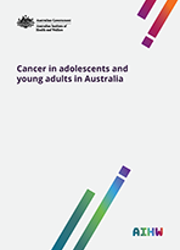Summary
This is the second national report to present comprehensive national statistics on cancer in adolescents and young adults aged 15–24 (also referred to as young Australians in this report). It provides an overview of cancers in young Australians, as well as key summary measures, including incidence, treatment, survival, prevalence, mortality, and disease burden. It also includes a spotlight section focusing on second cancers in young Australians.
Cancers in young Australians are rare, but have a large impact
In 2010–2014, 4,843 new cases of cancer (excluding basal and squamous cell carcinoma of the skin) were diagnosed in young Australians—an average of 2–3 cases per day.
In 2011–2015, cancer accounted for 8.8% of all deaths of young Australians. In 2011, cancer was the 7th leading cause of overall disease burden in young people, and the 2nd leading cause of fatal burden. Young Australians lost 6,850 disability-adjusted life years from cancer, with most of the burden due to dying prematurely (94%).
Melanoma was the most common cancer, and brain cancer was the leading cause of cancer mortality
In 2010–2014, melanoma was the most commonly diagnosed cancer in young Australians, accounting for 15% of all cancers diagnosed. But age-standardised incidence rates for melanoma fell from 96 new cases per 1 million young Australians in 1985–1989 to 44 new cases per 1 million in 2010–2014.
In 2011–2015, brain cancer was the leading cause of cancer mortality in young Australians, accounting for 18% of all cancer deaths. But age-standardised mortality rates from brain cancer fell from 7.6 deaths per 1 million young Australians in 1981–1985 to 5.8 deaths per 1 million in 2011–2015.
Cancer survival is high
In 2010–2014, young Australians diagnosed with cancer had, on average, an 89% chance of surviving for 5 years. Relative survival from all cancers combined for young Australians rose from 80% in 1985–1989 to 89% in 2010–2014, though changes in 5-year relative survival varied between cancer types.
Young cancer survivors are at an increased risk of developing a second cancer
In 1982–2014, 725 second cancers were diagnosed in those who had their first cancer diagnosed when aged 15–24, representing about 3% of all young cancer survivors.
For cancer survivors who had been diagnosed as an adolescent or young adult, the risk of developing a second cancer was 1.9 times as high as for the general population (2.2 times for males; 1.8 times for females).
The majority of second cancers had an initial diagnosis of Hodgkin lymphoma, followed by melanoma, gonadal germ cell cancer, and non-Hodgkin lymphoma.
Preliminary material: Acknowledgments; Abbreviations; Symbols
1 Introduction
1.1 Purpose and structure of this report
1.2 What is cancer?
1.3 Who are adolescents and young adults?
1.4 Why is examining cancer in adolescents and young adults important?
1.5 How are cancers in adolescents and young adults classified?
1.6 Data interpretation
2 Incidence of cancer
2.1 Incidence of all cancers combined
2.2 Incidence by cancer type
2.3 Incidence of cancer by sex
2.4 Incidence of cancer by age
3 Treatment for cancer
3.1 Hospitalisations for all cancers combined
3.2 Hospitalisations by cancer type
3.3 Hospitalisations for chemotherapy
3.4 Radiotherapy for cancer
4 Survival from cancer
4.1 Survival from all cancers combined
4.2 Survival by cancer type
4.3 Survival by sex
4.4 Survival by age
4.5 Survivorship population (prevalence)
5 Mortality from cancer
5.1 Deaths from all cancers combined
5.2 Deaths by cancer type
5.3 Deaths from cancer by sex
5.4 Deaths from cancer by age
6 Burden of cancer
6.1 Burden of all cancers combined
6.2 Burden by cancer type
6.3 Burden of cancer by sex
6.4 Burden of cancer by age
7 Focus on key population groups
7.1 Aboriginal and Torres Strait Islander people
7.2 State and territory
7.3 Remoteness area
7.4 Socioeconomic group
8 Second cancers
8.1 Second cancers
8.2 Second cancers by sex
8.3 Second cancers by age
Appendixes:
Appendix A: Cancer classification systems
Appendix B: Supplementary data tables
Appendix C: Data sources
Appendix D: Definition of cancer-related hospitalisations
Appendix E: Method to calculate second cancers
End matter: Glossary; References; List of tables; List of figures; Related publications
Data tables: Cancer in adolescents and young adults in Australia (1.2MB XLS)



